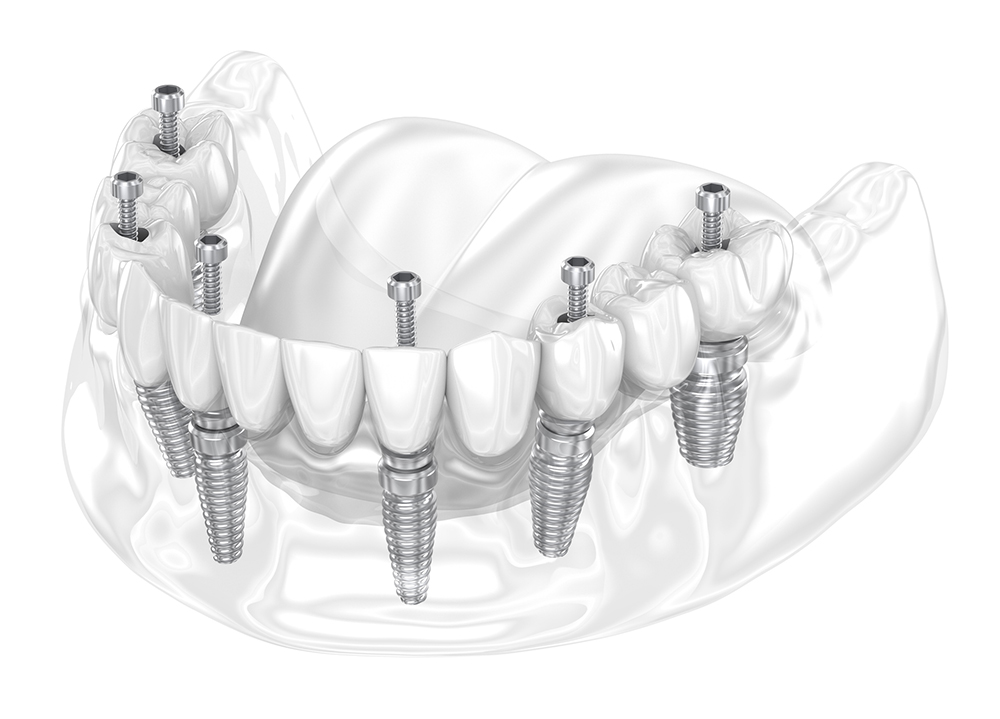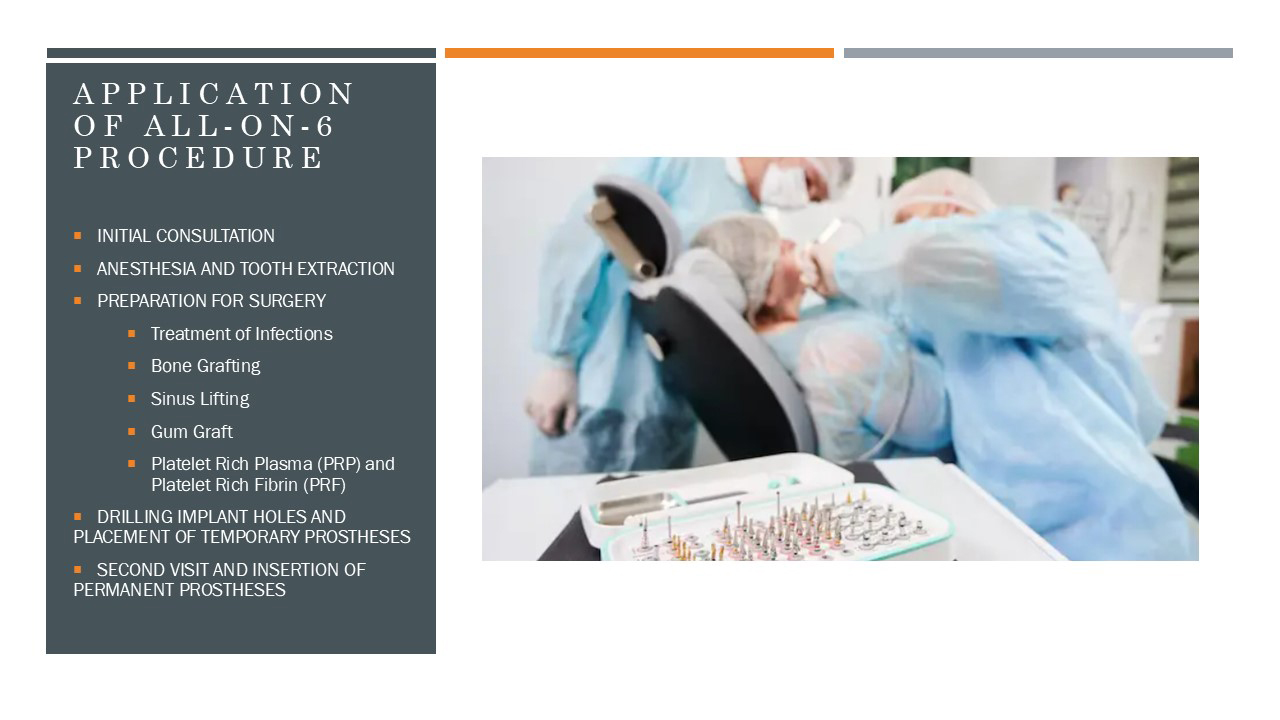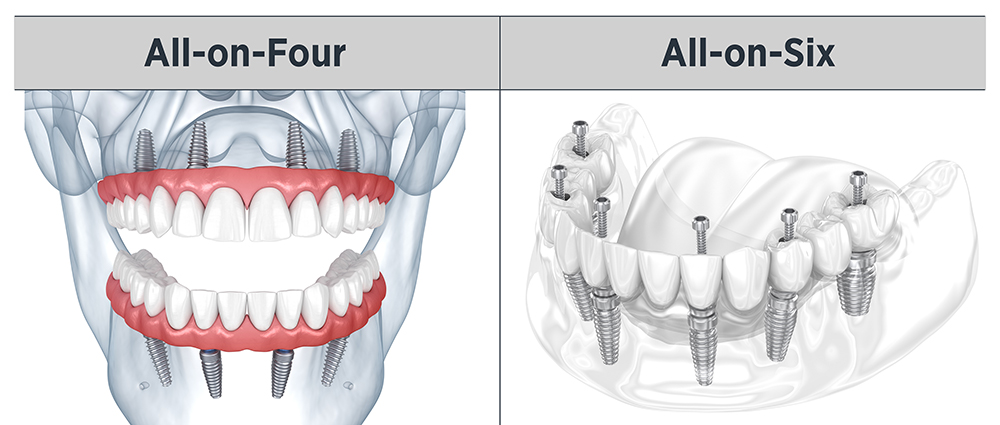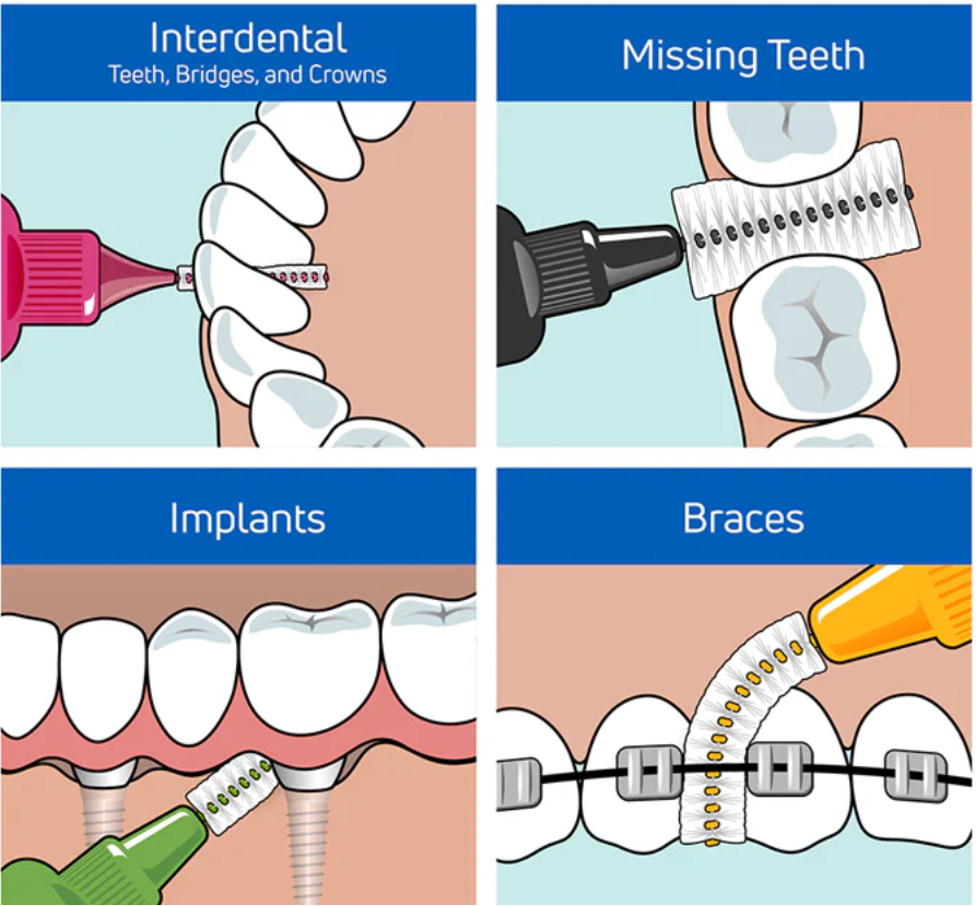All-on-6 Dental Implants. Smile Bold.
Only for boundary-breakers .


Beyond the dentristy.
If you've ever lost a tooth or needed a replacement, you might have heard about All-on-6 Dental Implants.
They are a popular solution that not only looks and feels like your natural teeth but also offers long-term benefits. In this page, we’ll walk you through everything you need to know about all-on-6 Dental Implants in a simple and easy-to-understand way.
All-on-6 Dental Implants

All-on-6 is an alternative to the All-on-4 dental implants for patients with healthier bone volume in the upper and lower jaw. As the name suggests, this technique is carried out with six implants. As long as the patient's orthodontic structure permits, the implants used in the All-on-6 procedure are positioned horizontally, parallel to one another, at equal intervals, and perpendicular to the jawbone.
The name of the procedure gives the impression that All-on-6 necessitates six implants. However, during the application, dentists can place an additional implant at the front jaw so that there is less stress to the rear implants. Additionally, you may select All-on-4 for the lower jaw and All-on-6 for the upper jaw, since the bones in the lower jaw are stronger.

Generally speaking, there are two parts to the All-on-6 procedure. The initial stage encompasses the duration leading up to the insertion of the patient's temporary implants, while the subsequent stage involves the placement of permanent implants following the integration of the implants with the jawbone. At these two stages of the process, the patient can expect the subsequent procedures in their treatment.
CBCT examination
Initially, the patient who arrives at the clinic for All-on-6 treatment undergoes a comprehensive intraoral examination using CBCT. This evaluation is followed by a discussion with the patient about their treatment options, including All-on-6 and any alternatives.
Occasionally, CBCT scans may show that a patient is not a suitable candidate for All-on-6. Specifically, patients who have experienced no posterior teeth for a long time and lack adequate bone density. CBCT evaluations also assess the patient's linear bone structure and the width of the jawbone. Before All-on-6 can be performed, the patient must meet all specifications concerning their bones.
Initial Consultation
After deciding to go through with the All-on-6 procedure, the consultation is when the specifics of the smile makeover and the treatment plan are ironed out. During this interview, we will examine the patient's social status and expectations extensively. It is essential for the patient to articulate their expectations accurately at this stage.
Anesthesia and Tooth Extraction
The All-on-6 procedure is typically conducted under local anesthesia. However, the patient's preferences and the nature of the procedure dictate whether or not general anesthesia is used. Once the patient is under anesthesia, the dentist will remove any remaining teeth and make any necessary preparations for the implant.
Preparation For Surgery
There are a few preliminary steps taken in the implant areas for All-on-6 treatment, as the implants will be placed in a horizontal line parallel to the jawbone. The following treatments may be part of these preparations, though they differ from patient to patient.
Treatment of Infections:
Comprehensive sanitation of the implant sites and the entire oral cavity is essential for the success of all-on-six treatment. This is because dental implant failure can be significantly accelerated by bacterial infections. Thus, prior to treatment, a thorough cleaning of the mouth is carried out.
Bone grafting:
Bone grafting is a procedure aimed at augmenting the bone volume in the implant site. The implant area is treated by applying bone powder to ensure that it reaches the desired hardness.
Sinus Lifting:
Sinus lifting is necessary for patients whose sinuses protrude into the implant cavity. The aim of the treatment is to prevent the implants from piercing the sinus cavity.
If the areas to be implanted have a significant amount of gum recession, the implant may fail due to inadequate gum after the procedure. This treatment involves the transfer of soft tissue from the oral cavity to the implant site through gum grafting.
Platelet Rich Plasma (PRP) and Platelet Rich Fibrin (PRF)
In these procedures, the patient's blood is subjected to centrifugation to yield plasma enriched with platelets and growth factors. With PRF treatment, a denser follicle is obtained and a more controlled healing is achieved, offering a faster fusion process following the treatment.
Drilling Implant Holes and Placement of Temporary Prostheses
The initial phase of treatment concludes with the drilling of the implant holes and the insertion of temporary prostheses. Then the patient is discharged with temporary prostheses. For the swelling and pain to subside, it is necessary to wait for two days following the treatment. A weeklong course of antibiotics is administered to the patient in order to mitigate the risk of infection just after the implant insertion.
Second visit and insertion of permanent prostheses
After the placement of temporary prostheses, a typical waiting period of 3 to 6 months is necessary for the implants to integrate into the jawbone. After this time, the patient makes a second appointment at the clinic to receive permanent implants.
While a single session may theoretically suffice for permanent implants, multiple rehearsals are typically conducted over several days to ensure optimal smile design. So, permanent prostheses are then fabricated and affixed to the patient based on the smile design established during these rehearsals.

The following are the main advantages of All-on-6 treatment.
Restoration of Chewing and Biting Functions:
The All-on-6 treatment restores the patient's chewing and biting capabilities. The pressure exerted during biting is conveyed to the jawbone via the implants, with the six implants utilized in All-on-6 facilitating this transmission at an optimal level.
Thus, in All-on-6 treatment, it is possible to distribute the bite force evenly to the jawbone. In All-on-4 treatment, the reduced number of implants results in uneven distribution of bite pressure across the jawbone.
Aesthetic Appearance:
The treatment enhances patients' self-confidence by offering an appearance like your natural teeth. The implants are situated in close proximity to one another as a result of the number of implants utilized in the All-on-6 treatment. This reduces the need for porcelain gums called pink aesthetics and makes the natural gums more visible.
Longevity:
The All-on-6 procedure is a long-lasting procedure; while prostheses must be changed every ten to fifteen years, the implants placed can last a lifetime with proper oral care.
Bone Preservation:
In All-on-6 treatment, implants are positioned equally and in parallel alignment. This provides support to the jawbone and prevents the resorption of jawbones. Implants placed in the back areas of the jaw during All-on-6 treatment are especially crucial for keeping the jawbone protected because it becomes more porous as one moves towards the back of the mouth.
Continues its function in case one of the implants falls out:
In the event that a patient undergoing All-on-6 treatment experiences a loss of an implant, scheduling a dental appointment will not disrupt their daily routine. Nevertheless, immediate dental attention would be required in the event that an implant were to fall out during All-on-4 treatment.
Cost-effectiveness:
There is typically no additional expense associated with All-on-6 treatment, despite the fact that it uses two more implants than All-on-4. Having said that, the treatment's benefit is substantially higher.

The primary distinction between All-on-4 and All-on-6 lies in the incorporation of two additional implants. However, the major distinction lies in the way the All-on-4 method is applied.
In the All-on-4 procedure, the two longest implants are angled and positioned in the jaw's most densely packed area. Therefore, although fewer implants are used in the All-on-4 method, these implants can provide better adhesion than a standard implant. On the downside, the All-on-4 method cannot manage the stress distribution that occurs during chewing as well as All-on-6 due to the use of fewer implants and cannot provide equal distribution to the jawbone.
From an aesthetic perspective, the All-on-6 technique exhibits a more natural appearance than All-on-4 due to the closer implant spacing.
Finally, functionally, the All-on-6 method provides a more comfortable chewing experience. Because the spacing between implants is minimal in the All-on-6 method, problems such as food entrapment are unlikely to develop.
In All-on-6 treatment, swelling usually peaks in the first 48-72 hours after treatment and then starts to diminish. Within 5-7 days, it should go away entirely. Bleeding, on the other hand, usually decreases and stops completely within the first 24-36 hours. However, if excessive bleeding continues, a doctor should be consulted.
During this process, the patient is advised to consume soft food, keep his/her head elevated and apply cold compresses outside the mouth. To help the patient through this process more comfortably and to prevent infection, antibiotics and painkillers are prescribed for a week after the treatment.

Despite the high success rate of All-on-6 treatment, two major factors influence the treatment's effectiveness.
- In the All-on-6 method, certain implants are inserted in the posterior regions, that is, in areas where the jaw bone is relatively soft. This means that the treatment may not work for patients who have sustained bone loss in these regions.
- All-on-6 treatment may require more surgical procedures and bone augmentation operations than the All-on-4 method. Therefore, this increases the risk of infection during or immediately after treatment. This is why All-on-6 therapy places a premium on pre-treatment eliminating infections.
The cost of All-on-6 treatment differs by clinic and significantly varies by country of application. Below, you can review the supplementary fees that may be incurred for All-on-6 treatment across various countries.
| Country | All-on-6 Treatment $ | Infection Treatment $ | Bone Graft $ | Sinus Lifting $ | Gum Graft $ | PRP Treatment $ |
|---|---|---|---|---|---|---|
| United Kingdom | 20000 | 500 | 3000 | 3500 | 1200 | 500 |
| United States | 25000 | 600 | 4000 | 4500 | 1500 | 700 |
| Germany | 15000 | 400 | 2500 | 3000 | 1000 | 600 |
| Turkey | 6000 | 150 | 800 | 900 | 300 | 200 |
| Mexico | 8000 | 200 | 1000 | 1200 | 400 | 250 |
| Hungary | 7000 | 180 | 900 | 1000 | 350 | 220 |
The All-on-6 treatment was initially introduced in 2005 and gained global acceptance as a fixed prosthesis solution as of 2010.
In these procedures, referred to as All-on-X treatments, patient testimonials indicate highly satisfactory outcomes. The treatment not only rehabilitates the patient's teeth but also significantly enhances the aesthetics of the jaw and face, which is greatly valued by patients.
Below, you will find the most frequently asked questions and responses regarding the All-on-6 treatment.
How long do All-on-6 dental implants last?
Unless there is a significant impact or complications, such as bone loss, all-on-6 dental implants are expected to last for an entire lifetime. Nevertheless, implant prostheses typically require replacement every 15 to 20 years. Despite the absence of issues like breakage or functional loss in the implants after this duration, microscopic fissures on the prostheses may lead to discoloration. So, they might need to be replaced.
The longevity of All-on-6 implants may be influenced by certain autoimmune disorders, particularly diabetes. In these patients, implant root infection is inevitable and may cause implant loss.
How painful is the All-on-6 procedure?
The All-on-6 treatment is a local procedure that is typically administered under local anesthesia, ensuring that the patient experiences no discomfort during the procedure. The anesthesia's efficacy is also enhanced by the thorough cleaning that occurs prior to the treatment.
Can patients with bone loss have All-on-6 implants?
For the all-on-six treatment, the patient should preserve his or her linear jawbone. Given that the implants are positioned at uniform intervals and parallel to one another in this procedure, it is crucial for the patient to possess adequate bone density.
Nevertheless, a bone augmentation treatment may be conducted if the patient has minimal bone resorption. If, however, there is a substantial amount of bone resorption, the All-on-4 treatment works better in such cases. Bone resorption has the most detrimental impact on implant treatment in the upper jaw. Due to the mandibular bone's robust structure, All-on-6 is more appropriate for the lower jaw.
How should I care for All-on-6 implants?
The All-on-6 treatment utilizes interdental brushes designed specifically for implants and braces, allowing for easy access between teeth, as well as dental floss tailored for this procedure. Naturally, maintenance also includes the recommended two daily brushings. Furthermore, under a dentist's supervision, All-on-6 dental implants should be cleaned once a year.

Can All-on-6 implants be removed?
All-on-6 dental implants are non-removable by the patient, yet they can be extracted by a dentist due to their threaded design.
Can All-on-6 implants be placed immediately after tooth extraction?
Following tooth extraction, contingent upon the patient's condition, All-on-6 implants are inserted and temporary dentures affixed. Nevertheless, surgical intervention for bone or gum healing, or a sinus lifting procedure, is often necessary. These treatments are followed by the drilling of holes and the placement of dental implants.
Will All-on-6 implants affect my speech?
All-on-6 is the most effective fixed prosthesis treatment that replicates the functionality of natural teeth and does not have any adverse impact on your speech. However, it may take some time until you adjust to your new teeth and no longer feel like you have bulky teeth.
What materials are used for prosthetic teeth?
All-on-6 treatments use titanium implants, as with standard implant procedures. Zirconium implants, on the other hand, have been around since 2019 and are still preferred over titanium ones due to their superior biocompatibility.
Here at Avita smile, we only work with the most reputable dental implant manufacturers, like Straumann. Compared to inferior brands, the titanium employed by these companies is of superior quality. Furthermore, these brands do not utilize metal alloys, such as nickel, which are found in more economical implant brands.
Is the All-on-6 procedure safe for people with medical conditions?
For All-on-6 to be successful, the patient's auto immune system must function optimally during the healing process, implant fusion to the jawbone, and post-treatment period.
Therefore, it is preferable for patients undergoing All-on-six treatment to not have any diseases affecting the immune system, like diabetes. In such cases, All-on-4 treatment is a possibility. In All-on-4 treatment, implants are positioned in the densest bone, resulting in a reduced healing time for the implant sites and expedited osseointegration with the jawbone.
How does smoking affect All-on-6 implants?
Smoking significantly contributes to the failure of implant treatment, particularly during the integration of implants with the jawbone. It can facilitate the rapid dissemination of germs within the oral cavity.
It can also expedite the accumulation of bacteria in the implant roots, where it is typically challenging for microbes to establish themselves. The success of the All-on-6 procedure is greatly compromised if the patient smokes or drinks excessively, particularly while the implants are being boiled down, because there are a minimum of twelve implant holes drilled into each jaw and each of these holes is susceptible to infection.
Conclusion
With All-on-6 treatment, it's vital to get the right diagnosis, and the procedures must be carried out with extreme caution to minimize the risk of infection. The success of the treatment requires accurate planning as well as advanced imaging equipment. Failure to do so will result in an unsuccessful All-on-6 procedure. Also, it takes a skilled dentist who can accurately assess patient expectations when it comes to the treatment's aesthetics.
Avita Smil's notable success in All-on-6 and All-on-4 treatments is attributable to its collaboration with dentists possessing 20-30 years of experience, primarily serving European patients, thereby enabling a thorough understanding of patient expectations.
Our cutting-edge CBCT equipment has 3D imaging capabilities backed by artificial intelligence, allowing us to execute treatments with pinpoint precision. Furthermore, we exclusively collaborate with industry-leading brands and meticulously employ top-notch materials in our treatments.
Timeline to your new smile.
A more beautiful version of your present smile.
Dental Health is our super and only one specialisation.
Dental & oral health is our passion. The goal is a less obvious, natural and more beautiful version of your current smile and oral health.
Bright smile.
Illuminate your world with a smile that shines bright and exudes confidence.
Confidence booster.
Unlock your true potential with a smile that boosts your confidence.
Pure & perfect.
Experience the pinnacle of dental perfection with avita dental treatments.









